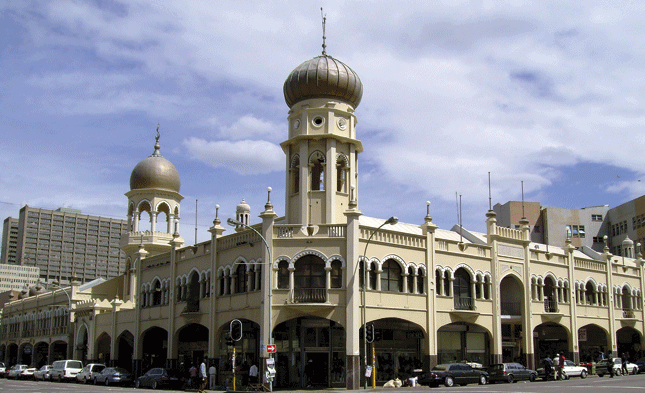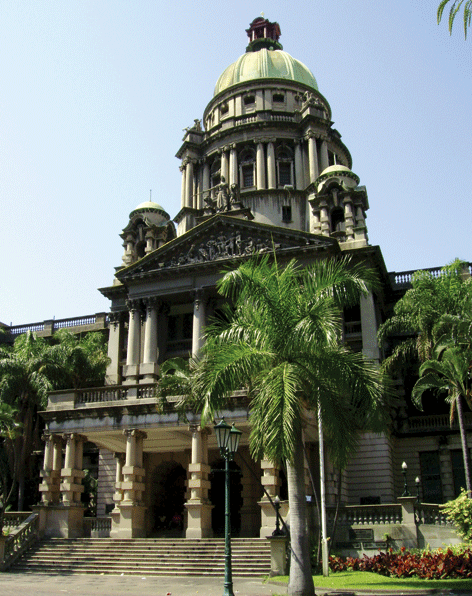
Travel
Durban
A Slice of Europe
and India in Africa

Africa, India and Europe meet in Durban, South Africa's third largest city.
Given the ethnic and cultural variety, most visitors can feel at home at once in this
cosmopolitan city on the east coast of the country.
By Rufaida Javid *
Few people outside South Africa would have heard of Durban, given its low-profile when compared to cities like Cape Town and Johannesburg. But inside the country, this beautiful city is the undisputed holiday capital. It has a subtropical climate, great food, splendid beaches (which are popular with surfers), excellent water sport facilities and golf courses. Greater Durban has a population of 2.4 million, and is just a 5-hour drive from South Africa's largest city, Johannesburg.
In the 15th century, Vasco da Gama reached its shores and named the place Rio de Natal. But it was the British who built a settlement there in 1824, after securing the permission from the fearsome Zulu king Shaka. The city derived its name from Sir Benjamin D'Urban, who was the governor of the Cape Colony.
Durban is also known as the “Indian capital” of South Africa. Indeed, the connection with India is so strong that in some parts of the city, you will be forgiven for thinking you are in Gujarat or Tamil Nadu. Even the local newspapers publish weekly supplements on Bollywood gossip, and Hindi movies regularly play to packed cinema halls.
Indians were first brought by the British to Durban as indentured laborers in the sugarcane plantations in the early 20th century. But many, especially those from Gujarat, also came as merchants. Among them, the father of the late Islamic scholar, Shaikh Ahmad Deedat, who is perhaps one of the best known South Africans in the kingdom and the wider Middle East. 
Not surprisingly, Durban is also home to one of the largest mosques in the Southern Hemisphere. The imposing Juma Masjid is located at Grey Street in downtown Durban. Deedat's Islamic Propagation Center International (IPCI), which is nearby, organizes free guided tours of the mosque for those interested. In July this year, the imam of Masjid Al Nabawi in Madinah Al Munawarrah delivered a lecture to a packed house at the IPCI headquarters.
Perhaps the most famous Indian resident of Durban was Mahatma Gandhi. His Phoenix Settlement - where you can see the house in which Gandhi lived and the printing press that he had set up - is just about 20km from the city center. Entry to his house is free. Inside, you can see a variety of photographs depicting scenes from Gandhi's life, both in South Africa and in India. For history buffs, this is a must-see.
If you have time on your hand, do also visit the small town of Pietermaritzburg, about 80 km from Durban. It was here that Gandhi was thrown out of the first class, whites-only compartment of the train. His statue today stands at the same railway station.
Durban is green and pleasant, with well-marked and well-maintained motorways. This is what the writer Mark Twain had to say when he visited Durban in the 19th century: “In the midst of green lawns with shrubs and generally one or two intensely red outbursts of poinsettia, the flaming splotch of blinding red [is] a stunning contrast with the world of surrounding green. . . . All about you is a bewildering variety of unfamiliar and beautiful trees ...” Perhaps Twain was referring to the Botanical Gardens on Sydenham Road in the Berea suburb, a must-see if you have even the slightest interest in plants.
If water sport is what drives you, then there are few places like Durban. This city is called surfers' paradise, and not without reason. At the beach along the Marine Parade, you will find people on surfboards navigating the waves. In fact, our guide told us that some foreign tourists come all the way to South Africa only to surf on the Durban coast.
Food is Durban is delightful. And yes, it is can broadly be divided into African, Indian and European cuisine. But the most dominant cuisine is Indian - or sub-continental, as there are many good Pakistani restaurants that have sprung up as a result of the immigration of Pakistani businessmen since the end of Apartheid.
The “bunny chow” is to Durban what the shawarma is to the kingdom: the most popular fast-food dish. You must try it out. It consists of a bun, the middle of which is scooped out, and filled with curried mutton or chicken. The best bunny chow can be found in the fast-food stalls at The Workshop shopping mall, off Commercial Road. 
South Africa is undoubtedly one of the most beautiful countries in the world. But its one major drawback is the crime factor.
Though crime in Durban is nowhere near what it is in Johannesburg, it still pays to take precautions. The trick is to avoid coming across as a tourist. Keep your cameras and tourists maps hidden. And don't wander around the beach front after dark. It is also a good idea to hire a local guide. And whatever you do, do not use public transport - which mainly consists of minibuses that will stop when you flag them down, much like the coasters in Riyadh - as it is not safe for tourists to do so.
Sightseeing
• The Botanical Gardens are open daily 7.30 am to 6 pm. Admission is free.
• The Victoria Street Market, at the corner of Victoria and Queen Streets, is open from basically dawn till dusk.
• If you have interest in the arts, then visit the Bartel Arts Trust, a complex of galleries and studios, where you can find local artists at work. For details, check out their website at www.batcentre.co.za
• Don't miss the Kwa Muhle Museum on Ordnance Road. The museum showcases the history of apartheid in the city, and how it was put into practice. Entry is free. For details contact (27-31) 300-6313
Where To Stay
Many of the best hotels are along the coastal “Golden Mile” area. We stayed at the Beach Hotel (SR300 with breakfast).
Visas
Most visitors need a visa to travel to South Africa. For details, contact the South African embassy in Riyadh.
* Rufaida Javid is a freelance writer based in Dubai.